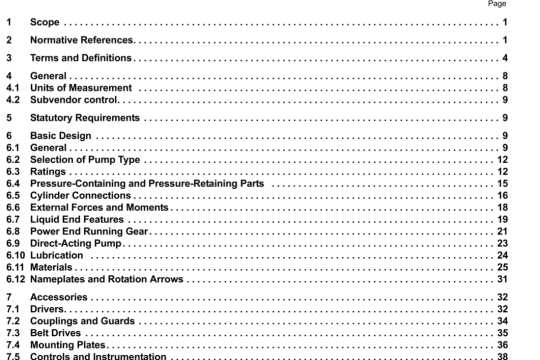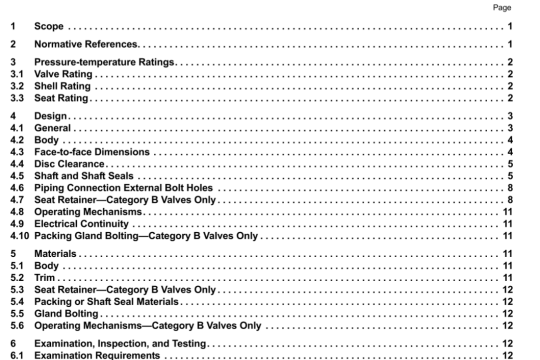API TR 17TR1:2003 pdf download
API TR 17TR1:2003 pdf download.Evaluation Standard for Internal Pressure Sheath Polymers for High Temperature Flexible Pipes.
6.9.3 In the dedicated extrusion ccli. the testpiece inner surface (equivalent to the sheath inner surface) is subjected to a constant elevated pressure at test temperature by means of an inert liquid. The tcstpiece is supported on its outer surface by a simulated pressure armour insert and the extrusion of matcrial into the armour grooves is monitored as a function of time. Extrusionlcreep characteristics depend upon a number of factors: polymer modulus. testpiecc thickness, armour geometry, temperature and pressure (stress). The test cell and its operation are described more fully in Annexe C.
6.9.4 For the candidate polymers studied in the development of this standard, strains generated locally within the extruded regions can exceed the global strain limit of 7.5%. Whether this is cause to reject a candidate polymer will depend on other factors, notably, whether HP gas service is envisaged (see scetion 6.12).
6.9.5 A candidate material is considered to fail the extrusion/creep test if the testpiece (which is realistically formed and of representative thickness. see Anncxe B) undergoes a greater than 3O/o reduction in thickness over its service life, estimated by extrapolation of the creep curve. This condition is clearly dependent upon armour gap geometry and sheath thickness. The wider and deeper the armour gap, the more likely that the pressure sheath will thin unacceptably.
6.10 DIMENSIONAL STABILITY TESTS
6.1 0.1 Dimensional stability tests are recommended for preliminary evaluation because the consticnces at the end fitting attachment points of a deficiency in this characteristic can be serious. Refer to Annexc D for full details of the test procedure to be employed.
6.1 0.2 The significant test variables are temperature and time. Dimensional stability tests are usually conducted in a vacuum oven. For preliminary evaluation purposes. a test emperawre at or close to the MST should he used; if this is not known, a temperature of 150CC should he employed. Changes in tesipiece mass, volume and dimensions are recorded at intervals over the test period, which may he several weeks. tinder normal circumstances, significant changes would only be expected in those candidate materials which are plasticized.
6.11 HP GAS PERMEATION TESTING
6.11 .1 See Annexe E for background theory. The permeability of the pressure sheath to relevant gases at high pressure (34.5 MPa (50(X) psi) and preferably service temperatures should be established by appropriate testing A dedicated HP gas permeation cell, in which polymeric testpicces machined from extruded pipe can be accommodated, was employed during the preparation of this standard. Methane (CH4) is the preferred permeant. The testpiece must be suitably scaled to prevent gas entering the polymer by any route other than the inner curved (service) surface. The build-up of permeated gas on the other surface of the sample is monitored and, once steady-state conditions have bccn established for a reasonable period, the test can be stopped and appropriate computations undertaken to obtain relevant coefficients:
permeation (Q), diffusion (D) and solubility (s). Thcsc effectively give rates for unit cubes of polymer and hence can be used for comparative purxscs.
6.11 .2 The variable parameters for the HP gas permeation tests are temperature and pressure. A typical test sequence involves making measurements at three (high) temperatures in order to develop Arrhcnius plots for each pressure for the coefficients of diffusion arid permeation (Annexe E); extrapolation to scrvicc temperature should then be possible if tests can only be performed at lower temperatures (NB if appropriate, care should be taken to ensure that Arrhenius-type linearity applies across the glass tran%ilion temperature T) of the polymer). lIP permeation tests should be performed on both unaged and aged testpieces (see Section 6.13 for details of ageing conditions). Additional detail is provided in Annexe l.
6. 11 .3 No passlfail criteria are specified for this test, If the gas permeation rate is high for a particular candidate material, pipe design considerations will dictate whether the material is allowable as a pressure sheath. The harriers to gas permeation presented by the carcass and pressure armour layers of a typical unbonded pipe should be considered when assessing performance. In the absence of these harriers, or if a proportionation factor describing their influence is known, permeation rate through the pipe sheath can be estimated once Q is known (see Annexe E).




